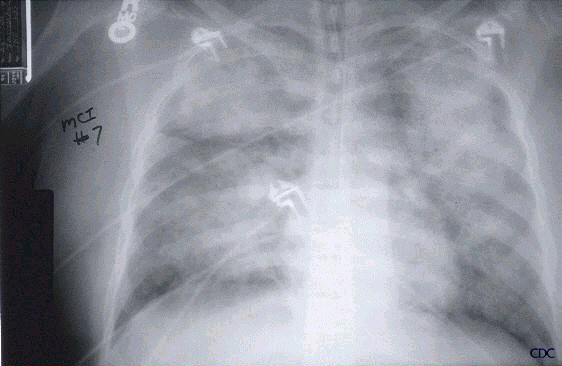Bubonic plague differential diagnosis: Difference between revisions
| Line 51: | Line 51: | ||
*Strangulated inguinal [[hernias]] | *Strangulated inguinal [[hernias]] | ||
**Evidence of bowel involvement. | **Evidence of bowel involvement. | ||
===Septicemic plague=== | ===Septicemic plague=== | ||
Revision as of 20:32, 17 December 2012
There are many diseases that resemble the basic signs and symptoms of bubonic plague. Since bubonic plague has the ability to kill the majority of a population, it is an extremely concerning diagnosis. It is very important to check for these other diseases before a final diagnosis of bubonic plague is made. There are many other bacterial infections that could be mistaken for the bubonic plague.
Differential diagnosis
The differential diagnosis of the plague can be broken down into three different categories based on the form of the disease.
Bubonic plague
- Streptococcal or staphylococcal adenitis (Staphylococcal aureus, Staphylococcal pyogenes)
- Purulent or inflamed lesion often noted distal to involved nodes (i.e., pustule, infected traumatic lesion).
- Involved nodes more likely to be fluctuant.
- Associated ascending lymphangitis or cellulitis may be present (generally not seen with plague).
- Tularemia (Francisella tularensis)
- Cat scratch fever (Bartonella henselae)
- Mycobacterial infection, including scrofula (Mycobacterium tuberculosis and other Mycobacterium species)
- With scrofula, adenitis occurs in cervical region.
- Usually painless.
- Indolent clinical course.
- Infections with species other than M. tuberculosis. more likely to occur in immunocompromised patients.
- Lymphogranuloma venereum (Chlamydia trachomatis)
- Chancroid (Hemophilus ducreyi)
- Adenitis occurs in the inguinal region.
- Ulcerative lesion present.
- Systemic symptoms uncommon; toxicity does not occur.
- Primary genital herpes
- Herpes lesions present in genital area.
- Adenitis occurs in the inguinal region.
- Although patients may be ill (fever, headache), severe systemic toxicity not present.
- Primary or secondary syphilis (Treponema pallidum)
- Enlarged lymph nodes in the inguinal region.
- Lymph nodes generally painless.
- Chancre may be noted with primary syphilis.
- Strangulated inguinal hernias
- Evidence of bowel involvement.
Septicemic plague
- Meningococcemia
- More likely to have evidence of meningitis (but not always present).
- Septicemia caused by other Gram-negative bacteria.
- Underlying illness usually present.
Chest X Ray
Some other infectious diseases can be differentiated by looking at chest x ray images. For example, SARS, Hantavirus syndrome, and Anthrax all need to be ruled out because they do present with some similar Symptoms. An example of a chest x ray for Hantavirus and Anthrax is shown.

